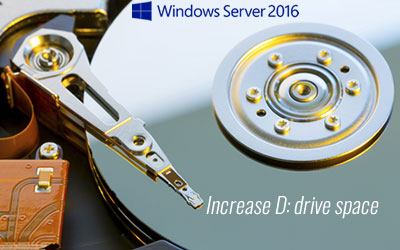System partition C is very likely getting full if you install everything into it. If you install all programs and some Windows services to D drive, it also runs out of space. In that case, you can increase size of D drive by moving free space from other volume on the same disk. There are several way to increase D drive size with Windows native tool and disk partition software. This article introduces how to increase D drive space in Windows Server 2016/2019/2022 without losing data.

Increase D drive space with inbuilt Disk Management
From Windows Server 2008, there is built-in "extend volume" function in Disk Management tool, which can help you extend part of NTFS partitions without losing data. However, only when your disk partition configuration meet all requirements below, you can increase D drive space in Server 2016/2019/2022 with Disk Management:
- There is another partition (such as E:) on the right side of D drive.
- You must delete the contiguous partition E.
- There's enough free space in other volume to save all files in drive E.
- Both drive D and E are the same primary or logical drive.
- Drive D must be formatted with NTFS file system.
To increase D drive space in Windows Server 2016/2019/2022 via Disk Management:
- Transfer all files in the right contiguous partition E to other place.
- Press Windows and X together on the keyboard, then click Disk Management in the list.
- Right click drive E and select Delete Volume.
- Right click drive D and select Extend Volume.
- Simply click Next till Finish in the pop-up Extend Volume Wizard window.
Although there's another "shrink volume" function, Disk Management cannot expand D drive by shrinking any volumes. (Learn why)
How to increase D drive size with diskpart command line
Diskpart runs from command prompt and it has many commands. Better than Disk Management, if the right adjacent partition E is primary, you can delete it to expand D drive with diskpart, no matter D is primary or logical.
To increase D drive space in Windows Server 2016/2019/2022 via diskpart:
- Transfer all files in drive E to other partition manually.
- Press Windows and R together on the keyboard, type diskpart and press Enter.
- Type list volume and press Enter in diskpart command prompt window.
- Type select volume E and press Enter.
- Type delete volume and press Enter.
- Type select volume D and press Enter.
- Type extend and press Enter.
However, if D is primary and E is logical partition, there are 2 additional steps before 6th step:
- Type select partition 0 and press Enter.
- Type delete partition and press Enter.
Better way to increase size of D drive with partition editor
With NIUBI Partition Editor, there are no such limitations and it is extremely easy to increase D: drive space in Windows Server 2016/2019/2022. The most important, you can increase size of D without deleting other volume.
Download NIUBI Partition Editor and follow the steps to increase D drive size by shrinking C or E:
More detailed info about extending D drive in Windows Server 2016.

